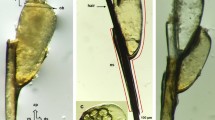Abstract.
An electron microscopic study of the endogenous development of Eimeria mulardi Chauve, Reynaud and Gounel, 1994 was carried out in mule ducks which are hybrids of the domestic duck (Anas platyrhynchos) and the muscovy duck (Cairina moschata). All of the endogenous stages were seen within the nucleus of the host cell. Merozoites arose from ectomerogony and three mutually similar merogonies were noted. The asexual stages were found in leukocyte-like cells in the lamina propria of the jejunum, ileum and caecum, while the gamonts developed in glandular epithelial cells in the same part of the intestine.
Similar content being viewed by others
Author information
Authors and Affiliations
Additional information
Electronic Publication
Rights and permissions
About this article
Cite this article
Pakandl, M., Reynaud, M. & Chauve, C. Electron microscopic study on the endogenous development of Eimeria mulardi, Chauve, Reynaud and Gounel, 1994: a coccidium from the mule duck. Parasitol Res 88, 160–164 (2002). https://doi.org/10.1007/s004360100509
Received:
Accepted:
Published:
Issue Date:
DOI: https://doi.org/10.1007/s004360100509




